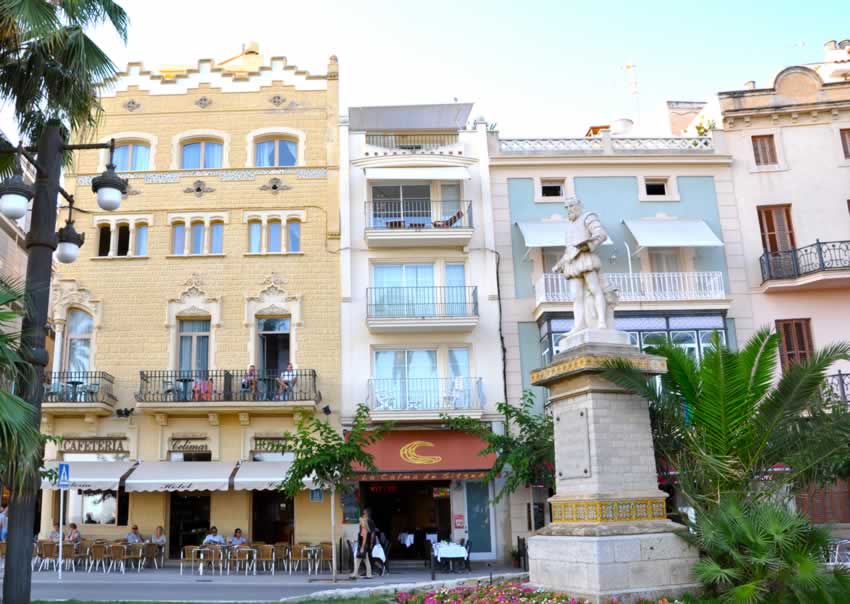
This itinerary begins in front of the town hall; the building itself dates from 1887-1889 and is built on the site of the medieval castle of Sitges. It is considered an example of Catalan civil gothic-style architecture due to the ornamental details of the windows and its coats of arms.
Facing the town hall, to our right are the gardens and the statue in memory of Doctor Robert (link a personaje histórico). Continuing round are the buildings of the Rectory, the Municipal Historical Archive (check opening hours on Tel. 938117628 should you wish to visit and access the historical and administrative documents) and the Santiago Rusiñol Library.
The Santiago Rusiñol Library includes a bibliographical and historical collection specialised in the artistic and literary movements of the end of the 19th and beginning of the 20th century. Loans can be arranged for home delivery for temporal or permanent mobility-impaired people. The library has Wi-Fi.
We recommend a quick visit (respecting the silence within) to see the library and courtyard. Tel. 93 8941149.
Hours:
Monday to Friday from 15:30 to 20:00h
Wednesday to Saturday from 10:00 to 14:00h
From June 15th to September 15th, Saturdays closed
On Saturday mornings in the winter months, there is L’Hora del Conte, (story telling for children) on the top floor. An adult tells a story which is acted out, involving the audience. (L’Hora del Conte also takes place on Friday afternoons in the winter months in the Josep Roig i Raventós Library on Plaza Catalunya Tel. 93 894 8486.)
On the left hand side of the town hall, very close to the Santiago Rusiñol library there is the historic Mercat Vell, a Catalan Art Nouveau building from 1890. Casa Barcardí was located there for the last years but left Sitges on 2021.
To the left of the mercat vell there is a little narrow street, Carrer d’en Bosc, which runs along the side and back of the building and connects with Carrer de la Davallada. This part of town has great charm and is well worth visiting. The Carrer d’en Bosc is one of the oldest streets in Sitges and was once a path that followed the inside of the town wall. In the 14th century, stone houses were built backing on to the town walls. Some of these carefully restored buildings remain visible today. One is the Palau del Rei Moro, a sumptuous medieval house, currently seat of the Sitges Group of Folkloric Dances, the inner patio of which serves as training ground for the Colla Jove de Castellers de Sitges. Next door is the Pinacoteca de Sitges (Fundació Stämpfil).
Leaving the Carrer d’en Bosc and going down the Carrer de la Davallada, on the left hand side there is a quaint little park with swings, below the old town wall. Children may play here while parents may take a seat at one of the tables of Bar La Guineu and have an aperitif in front of the swings. This little park faces the Miramar building where the Consorci del Patrimoni de Sitges (Sitges Heritage Consortium) holds very interesting exhibitions.
Leaving the swings, the route continues along Carrer Barcelona, which is the first street on the left hand side, going down Carrer Davallada (walking through the Bar La Guineu also gives access to Carrer Barcelona). This street features many old fisherman houses some of which have been restored. Happily the new builds are in character with the older constructions. At the end of the street continue along Carrer Àngel Vidal. (Despite being mainly pedestrian, there may be cars entering or existing the El Retiro parking.) At number 10 on Àngel Vidal we find El Pati Blau (the blue courtyard) made famous by having inspired and given title to one of the most notorious plays written by Santiago Rusiñol, which was published in 1903. On the façade of the building, under the name El Pati Blau, there is a tile plaque that reproduces an excerpt from the book Llibre de Sitges by Ramón Planas which could be translated as follows: “It was love at first sight. Rusiñol, just like Roig Soler and Mas and Fontdevila, had fallen in love with the luminosity of Sitges. Indeed it perfectly matched his romantic temperament and undertow of sorrow which was hidden under his smile, he also fell in love with our patios, of the patio azul”. Santiago Rusiñol made a painting of this blue patio in 1891. It is currently displayed in the Montserrat Museum.
At the end of Carrer Àngel Vidal is the Cap de la Vila, the historical centre where many streets converge. It is worth pointing out a beautifully renovated Catalan Art Nouveau construction from 1915 with a delightful watchtower, the Casa Bartomeu Carbonell i Mussons also popularly known as the Casa del Reloj (Clockhouse). Bartomeu Carbonell i Mussons (a textile trader) commissioned architect Ignasi Mas i Morell to design the building. (Mas i Morell also designed the Barcelona Monumental bullring.) One of the more striking features of the building is the tower’s 5 small roofs, tiled in the trencadis style (a type of mosaic used in Catalan modernism, created from broken tile shards, which Gaudí also employed). The enclosed wooden balcony on the second floor also deserves a special mention.
Gassó Fotògraf is in Cap de la Vila and this photo establishment is one of Sitges’ oldest. It has documented Sitges life since 1955. The window display always portrays photographs of the most recent events to take place in Sitges and inside there are some very interesting photos taken more than 50 years ago.
From Cap de la Vila one can go to l’Hort de Can Falç. These inner gardens can be accessed from the beginning of Carrer Parellades, by going down a small side street, Carreró de Can Falç that looks like a dead end, but is actually the entrance to the gardens as indicated on the iron door. It is pleasant and peaceful. There are a couple of swings, benches and toilets, a perfect time-out for the small members of the family.
l’Hort de Can Falç
Summer timetable: open Tuesday-Sunday from 10am to 9pm. Bank holiday Mondays open.
Winter timetable: open Tuesday-Sunday from 10am to 7pm. Bank holiday Mondays open.
After the gardens, a stroll may be taken along the Carrer Major that runs from Cap de la Vila to the Ajuntament (town hall). This street has many shops and singular buildings. On leaving l’Hort de Can Falç take the Carrer Parellades, one of the wider and more commercial streets in Sitges where there are also some very special buildings. Turn right on Carrer Bonaire towards Carrer Sant Josep to discover the Museu Romàntic, a 19th century house which illustrates life in that period. Perhaps one of the most interesting museums for children, it includes a collection of over 400 antique dolls.









































